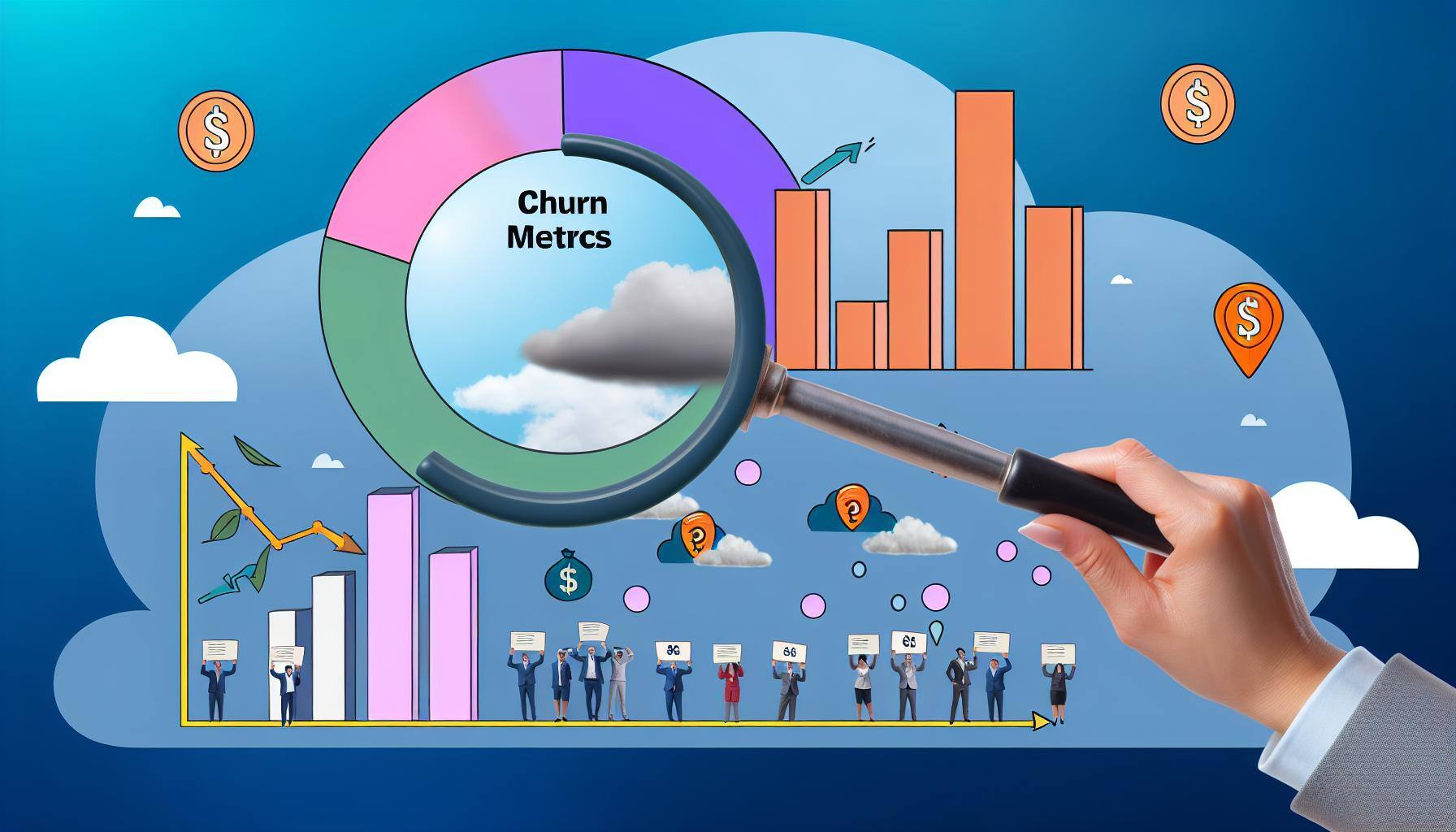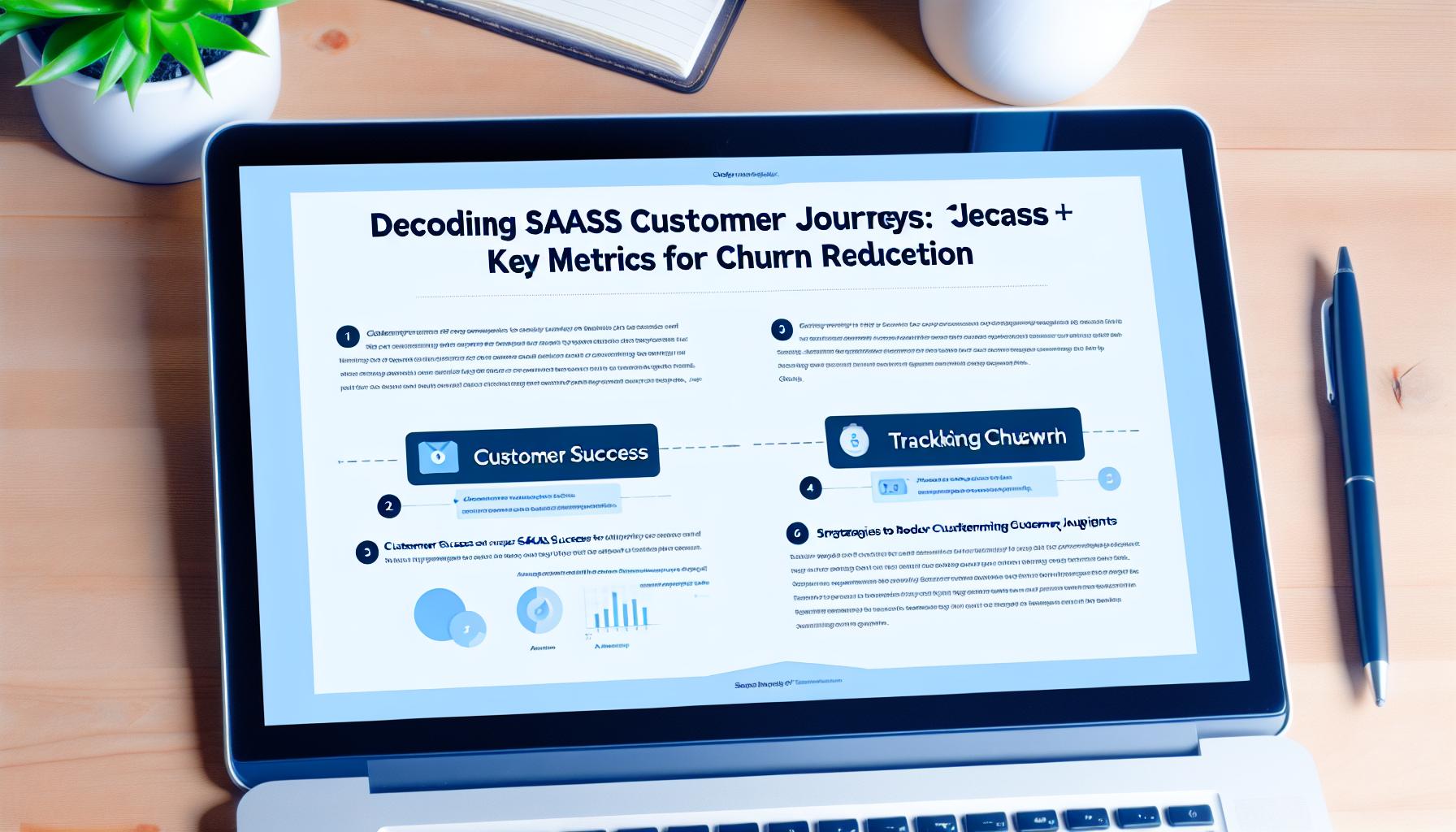Decoding SaaS Customer Journeys: Key Metrics for Success and Churn Reduction
Have you ever thought about how people decide to use a product or service? For companies that sell software, understanding their customers' journey...
8 min read
Brian Polackoff
:
Jun 17, 2024 12:57:00 PM

In the competitive landscape of Software as a Service (SaaS) businesses, understanding and leveraging key metrics are vital for sustainable growth and success. One such crucial metric that every SaaS company should meticulously track is the churn rate. Churn rate, an important SaaS metric, is a metric that tells you how much customer attrition your business is experiencing over a specific period of time, typically measured on a monthly or annual basis.
Churn rate is a fundamental metric for SaaS companies as it directly reflects customer satisfaction, product-market fit, and overall business health, making it one of the 18 SaaS metrics every SaaS company should care about. In the SaaS model, where revenue is generated through subscription-based services, customer churn rate can significantly impact the financial performance and growth trajectory of a company.
A high churn rate can impede SaaS growth by reducing Monthly Recurring Revenue (MRR), affecting Customer Lifetime Value (CLV), and increasing Customer Acquisition Cost (CAC). By monitoring and analyzing churn rate data, companies can identify trends, address underlying issues, and implement strategies to enhance customer retention and loyalty. Some strategies to reduce churn rate and improve SaaS growth include:
1. Develop a proactive customer success program: Implementing a proactive approach to customer success can help identify and address potential issues before they lead to churn. This can include regular check-ins with customers, personalized onboarding processes, and offering additional support and resources to help customers achieve their goals.
2. Enhance product features and usability: Continuous improvement of product features, functionality, and usability can help enhance the overall customer experience and satisfaction, addressing growth metrics and important SaaS metrics related to product development. Regularly collecting feedback from customers and integrating it into product development can help ensure that the product meets the evolving needs and expectations of users.
3. Provide exceptional customer support: Offering timely and responsive customer support can help build trust and loyalty with customers. Providing multiple channels for customers to reach out for assistance, such as live chat, email, and phone support, can help ensure that customers receive the help they need when they need it. This strategy supports the important SaaS metrics of customer engagement and satisfaction.
4. Implement a customer feedback loop: Regularly collecting and analyzing customer feedback can provide valuable insights into customer satisfaction and areas for improvement, highlighting the importance of integrating this process into your SaaS marketing strategy. Implementing a structured feedback loop, such as surveys, customer reviews, and Net Promoter Score (NPS) assessments, can help track customer sentiment and identify opportunities to enhance the customer experience.
5. Offer incentives for customer loyalty: Providing incentives, such as discounts, rewards, or exclusive perks, can help incentivize customers to remain loyal to your SaaS product, demonstrating the significant role of customer engagement metrics in a comprehensive marketing and sales strategy. Creating a customer loyalty program can help reinforce customer relationships and encourage repeat business.
By implementing these strategies and continuously monitoring and analyzing churn rate data, SaaS companies can take proactive steps to reduce churn, improve customer retention, and drive sustainable growth.
While churn rate is an important metric, it is essential for SaaS businesses to track additional metrics such as Monthly Recurring Revenue (MRR), Customer Acquisition Cost (CAC), Customer Lifetime Value (CLV), and Revenue Churn to gain a comprehensive understanding of their performance and make informed decisions to drive growth.
1. Monthly Recurring Revenue (MRR): MRR is the amount of revenue that a SaaS company expects to receive on a monthly basis from its subscribers. Tracking MRR alongside churn rate can help you understand the overall revenue impact of losing customers and can guide your efforts to attract new customers.
2. Customer Acquisition Cost (CAC): CAC is the amount of money a business spends to acquire a new customer. Monitoring CAC alongside churn rate can help you determine the overall cost of customer acquisition and whether it is worth spending that amount to acquire new customers if they are churning at a high rate.
3. Customer Lifetime Value (CLV): CLV (Customer Lifetime Value) is the total revenue a business can expect to generate from a customer over their entire relationship with the company, making it a key SaaS metric for evaluating the long-term value of the number of new customers. Tracking CLV alongside churn rate can help you understand the long-term impact of churn on your revenue and profitability.
4. Revenue Churn: Revenue churn is the amount of MRR lost from existing customers due to cancellations or downgrades. Monitoring revenue churn alongside churn rate can provide a more accurate picture of the financial impact of losing customers and can help you identify opportunities to improve customer retention and increase revenue.
By tracking these additional metrics alongside churn rate, SaaS businesses can gain a deeper understanding of their customer base, revenue streams, and overall performance, allowing them to make data-driven decisions to drive growth and success.
Customer Acquisition Cost (CAC) is a key metric that reflects the amount a company spends to acquire a new customer. For SaaS companies, optimizing CAC is essential for sustainable growth and profitability. By efficiently managing CAC, businesses can improve their Return on Investment (ROI) and enhance their customer acquisition strategies.
Calculating CAC (Customer Acquisition Cost) involves analyzing various cost components such as marketing expenses, sales commissions, and overhead costs related to acquiring new customers. It stands as a key SaaS metric that directly influences business profitability and growth metrics. By closely monitoring CAC and its associated metrics, SaaS companies can gauge the effectiveness of their marketing campaigns, evaluate customer acquisition channels, and make data-driven decisions to enhance performance.
To optimize CAC, SaaS businesses can focus on improving lead generation strategies, enhancing conversion rates, and nurturing customer relationships to reduce acquisition costs and increase customer retention. By continuously refining their customer acquisition processes, companies can achieve sustainable growth and competitiveness in the market.
Monthly Recurring Revenue (MRR) is a vital metric for SaaS companies, representing the predictable revenue generated from subscription-based services on a monthly basis. MRR provides insights into revenue stability, growth trends, and overall business performance. By effectively tracking MRR, businesses can forecast future revenue streams and assess the impact of pricing changes and customer upgrades on their financial health.
Various factors, including customer retention rates, upselling opportunities, and new customer acquisitions, can influence MRR levels in SaaS companies. By analyzing these factors and implementing strategies to enhance MRR, businesses can drive revenue growth, improve customer satisfaction, and strengthen their market position.
To increase MRR, SaaS companies can implement pricing optimizations, introduce tiered subscription plans, offer value-added services, and focus on customer success initiatives. By diversifying revenue streams, expanding customer base, and fostering long-term relationships, companies can boost MRR and achieve sustainable business growth.
Customer Lifetime Value (CLV) is a critical metric that helps SaaS companies understand the long-term value of each customer relationship. By analyzing CLV, businesses can segment customers, personalize marketing strategies, and prioritize customer retention efforts to maximize revenue and profitability. Here are some key reasons why CLV is crucial for the growth of SaaS companies:
1. Revenue Maximization: Understanding how much revenue a customer is likely to generate over their lifetime allows SaaS companies to allocate resources effectively and focus on acquiring high-value customers. By maximizing CLV, businesses can increase their overall revenue and profitability.
2. Customer Segmentation: CLV helps businesses segment customers based on their value to the company. By identifying high-value customers, SaaS companies can tailor personalized marketing strategies and offerings to better meet their needs and retain their business.
3. Customer Retention: By analyzing CLV, SaaS companies can identify which customers are at risk of churn and take proactive steps to prevent it. By prioritizing customer retention efforts for high-value customers, businesses can improve customer loyalty and reduce overall churn rates.
4. Strategic Decision Making: CLV provides valuable insights that can inform strategic decision-making for SaaS companies. By understanding the long-term value of each customer relationship, businesses can make informed decisions about pricing, product development, and customer acquisition strategies.
5. Competitive Advantage: SaaS companies that prioritize CLV analysis have a competitive advantage in the market. By focusing on maximizing customer lifetime value, businesses can differentiate themselves from competitors and build stronger, more profitable customer relationships. This approach is crucial among the metrics every SaaS company should monitor to encourage growth.
Annual Recurring Revenue (ARR) is a key metric that indicates the total revenue expected from subscriptions over a year. By analyzing ARR trends, identifying growth opportunities, and adjusting business strategies, SaaS companies can achieve long-term success, improve financial performance, and attract potential investors.
By tracking sales and marketing metrics such as lead conversion rates, customer acquisition costs, and customer retention rates, SaaS businesses can optimize their marketing campaigns, improve sales performance, and enhance overall customer experience. Effective management of these metrics is essential for driving sustainable growth and building a strong brand presence in the market.
Revenue churn occurs when existing customers discontinue their subscriptions or reduce their usage of services, leading to revenue loss for SaaS companies. By identifying common revenue churn patterns, such as pricing issues, service quality concerns, or lack of customer engagement, businesses can proactively address these issues and implement retention strategies to mitigate revenue churn.
1. Pricing Issues: One common revenue churn pattern in SaaS business models is when customers feel that the pricing plans are not aligned with the value they are receiving from the service. This could lead to customers downgrading their subscription level or canceling altogether. To address this issue, SaaS companies can conduct market research to understand their customers' willingness to pay and adjust pricing accordingly. They can also offer discounts or promotions to incentivize customers to remain loyal.
2. Service Quality Concerns: Another revenue churn pattern is when customers are dissatisfied with the quality of the service they are receiving. This could be due to bugs in the software, poor customer support, or lack of updates and improvements, all of which are vital metrics to track in SaaS marketing to ensure a healthy relationship with your company. To prevent revenue churn caused by service quality issues, SaaS companies should prioritize customer feedback and continuously work to improve their service. Investing in training for customer support teams and implementing regular software updates can help maintain customer satisfaction.
3. Lack of Customer Engagement: Customers who are not actively using a SaaS product are more likely to churn. This could be due to a lack of onboarding assistance, poor user experience, or a lack of understanding of the product's value. SaaS companies can combat revenue churn caused by lack of customer engagement by providing thorough onboarding processes, creating educational resources and tutorials, and regularly checking in with customers to ensure they are getting the most out of the product.
By recognizing these common revenue churn patterns in SaaS business models, companies can identify areas of improvement and implement strategies to increase customer retention and ultimately drive revenue growth. Additionally, utilizing customer feedback and analytics can help businesses proactively address issues before they lead to revenue churn.
To minimize revenue churn, SaaS companies can focus on enhancing product features, providing exceptional customer support, and offering incentives for renewals and upgrades. By fostering strong customer relationships, addressing customer feedback, and continuously improving service quality, businesses can increase customer satisfaction, loyalty, and reduce revenue churn rates.
1. Proactive customer communication: Reach out to customers before their renewal date to discuss their experience with the product, address any concerns they may have, and highlight new features or upgrades that may be of interest to them.
2. Customer feedback surveys: Regularly collect feedback from customers to understand their satisfaction levels, identify areas for improvement, and address any issues before they lead to cancellations.
3. Personalized customer retention campaigns: Create targeted marketing campaigns and offers based on customer behavior, usage patterns, and preferences to encourage upgrades, renewals, and upsells.
4. Customer success team: Establish a dedicated customer success team to proactively engage with customers, provide onboarding support, offer training sessions, and ensure that customers are maximizing the value of the product.
5. Flexible pricing and billing options: Offer flexible pricing plans, discount options, and payment terms to accommodate customers' changing needs, budgets, and preferences.
6. Loyalty programs: Reward loyal customers with exclusive discounts, special offers, early access to new features, or other incentives to encourage retention and reduce churn.
7. Regular product updates and enhancements: Continuously improve product features, performance, and user experience based on customer feedback, market trends, and competitor analysis to keep customers engaged and satisfied.
8. Prioritize customer support: Provide fast, efficient, and personalized customer support through multiple channels (e.g., chat, email, phone) to resolve issues quickly, answer questions, and ensure a positive customer experience.
9. Renewal reminders and follow-ups: Send timely reminders, renewal notifications, and follow-up communication to keep customers informed about their subscription status, upcoming billing cycles, and options for renewal or cancellation.
10. Monitor and analyze customer data: Use data analytics, customer metrics, and churn analysis to identify patterns, trends, and warning signs of potential churn, and take proactive measures to prevent customer attrition.
By utilizing relevant metrics and Key Performance Indicators (KPIs) such as Customer Churn Rate, Revenue Churn Rate, and Net Revenue Retention, SaaS companies can gain valuable insights into customer behavior, retention challenges, and revenue impact. By leveraging data-driven insights, businesses can develop targeted retention strategies, optimize pricing models, and enhance product offerings to combat revenue churn effectively.

Have you ever thought about how people decide to use a product or service? For companies that sell software, understanding their customers' journey...

In the ever-evolving landscape of Software as a Service (SaaS), understanding and tracking key metrics is vital for successful product management and...